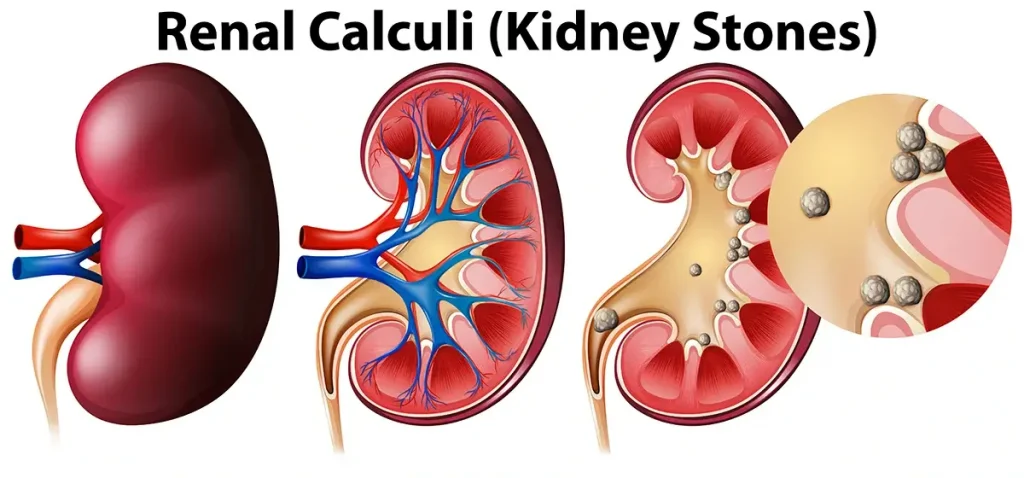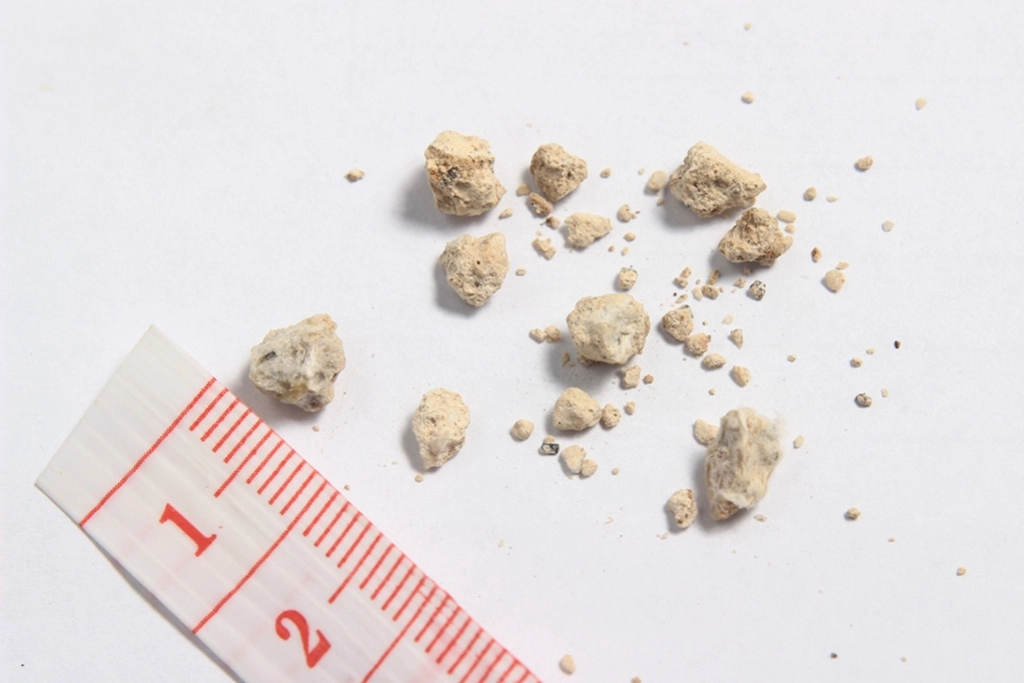There are 4 stages of passing a kidney stone: Creation, entering the ureters, reaching the bladder, and passing out.
Kidneys play a significant role in cleaning the system and throwing out excessive minerals our body doesn’t need via urine.
There are four stages of passing a kidney stone. However, sometimes, the mineral residue doesn’t pass and keeps bulging up inside the body, making stone-like shapes that can be smaller to bigger. These kidney stones sometimes pass through the kidney quickly without causing any pain or disturbance, and if they get bigger, a person can feel fever with chills, puking, pain in the back, and many other symptoms. Let’s discuss the passing process in detail, along with 4 stages of passing a kidney stone: The kidney stone passing process is not very pleasant and comes with warning signs, especially when the kidney stone is bigger in size. A kidney stone can be from less than 2 mm, like sizing a sand grain to 2 cm or more, equal to the size of a pea. In rare cases, it can go as big as a tennis ball and does not pass through the urinary system, requiring major surgery for removal. There are four stages in which a kidney stone goes through while passing out of the body through the urinary tract and bladder. There are four stages of passing a kidney stone—the organs involved in the Kidney stone passing are 3, i.e., Kidneys, ureters, bladder, and then out. Here is the detail: Don’t you drink enough water? You are at a higher risk of developing kidney stones. The elements in the body travel through the blood to provide energy to the body’s different organs. Kidneys clean the substance before letting it enter the body. The remaining is excreted through the urinary system. The remaining can consist of crystals. Water helps dissolve these crystals so they can pass easily through the whole system without causing pain or getting stuck anywhere. Lack of water can cause urine concentration, creating crystals by attracting different materials. At this stage, a person doesn’t feel any pain; however, they might sense some disturbance. As there is a continuous flow of fluids to and from the kidneys, so the crystals don’t stay or get stuck in there (when they are more petite in size). They keep traveling and reach the ureter. Most of the stones pass through the kidneys and reach the ureters. In rare cases, it doesn’t happen. The ureter opens up in the bladder; now, depending upon the size of the kidney stone or crystal, it tries moving to the next stage and each in the bladder. The stone, which is more than 1mm to 3mm, can cause severe pain episodes. Each time the rock (usually jagged, uneven corners) touches the wall of the ureter, significant pain is felt. The pain can be severe depending on the size of the stone and how sharp its edges are. More giant stones can cut the ureter walls causing bleeding, and people can have blood in their pee. More water is needed to drink to dissolve the crystals and make their size small or flow them out of the ureter. As all the excess water or nutrients from our body pass through the bladder, so form ureter, kidney stones will reach there, at stage 3. These stones, once again depending on the size, can cause severe problems in peeing; a person, along with feeling pain during urination, can also have blood in it. This can make urine hold in because it doesn’t find much room to pass out. So, you feel the urge to urinate more frequently while the excretion quantity is so tiny. This can be painful too. There are chances that you will see other symptoms like a feeling of throwing up or having a fever with chills. Small stones get removed from the body without causing pain through urine. Kidney stones grown in size are cut into pieces through home remedies and various medical procedures to make their passing out easy. At this stage, a person might feel minor pain because of the disturbance caused by the crystals while they were in the body. However, in some cases, no pain is reported for this stage. There is no difference in passing procedures or stages of passing a kidney stone in men and women because everything goes the same way. However, according to the latest research, women are more likely to develop KSD than men. This could be because women are more into consuming non-food items such as cornstarch that doesn’t pass out of the body and can be a cause of creating stones. When you are passing a kidney stone, here are some signs and symptoms you might experience, such as: The following diagram shows the stages of passing a kidney stone path: The passing of a kidney stone depends on its size. The duration of the passing of stone lies between one week and several. It takes one week or seven days to pass or exit from the body during the stages of passing a kidney stone. A person doesn’t need any sort of medication but simple lifestyle changes. Such as drinking plenty of water (more water than usual) and avoiding foods that may trigger stone formation. 2-millimeter or 3-millimeter stones are bigger in size. So their passing duration is more than just one week. You might even feel slight throbbing pain during this. Your doctor will recommend you drink plenty of water and offer a food chart based on items that will not make kidney stones but help in the easy passage of the current ones. Stages of passing a kidney stone when it is 2 to 3 mm in size are treatable with home remedies and can take around 2 weeks to pass out. You can feel pain in the back, sides, or abdominal area. These more giant stones can take around 6 months to remove from your body entirely. You will be recommended painkillers, home remedies, and several tests for such a big stone, and you might have to stay in observation. This can take around one month, and you will not be able to remove it by using home remedies. You need a proper health checkup. Your doctor can recommend Ureteroscopy. During this, a small telescope is passed through the urethra and bladder to point to the location of the stone. However, it is not a major surgery or something to worry about. This is typically called an outpatient procedure, which means your doctor will allow you to go home the same day after the treatment. Well, we cannot determine a period for such big stones. It depends on the nature of the treatment you take, as there are several options, including lithotripsy and percutaneous nephrolithotomy. During such procedures, the first stone is torn into several pieces and waited to come out via the stages of passing a kidney stone or picked from the body by making a hole in the backside. Your GP will recommend that you use a strainer while peeing and get the stones so they can examine the root cause of this crystal formation. During this, you might feel a pinching sensation in your bladder. You also may feel that your bladder has not been fully emptied, and you get the urge to urinate more. Here are some images showing what a kidney stone looks when exiting the body after going through the stages of passing a kidney stone. Here our discussion comes to an end. We have discussed the 4 stages of passing a kidney stone in detail. We have also discussed the period a kidney stone can take to pass out, depending on its size and the crystals it is made of. For more information on health and read detailed blogs on health issues and solutions, you can browse our health category. For more information, keep visiting us, and if you still have any questions regarding the stages of passing a kidney stone, feel free to write to us.

Kidney Stone Passing Process
Stages of Passing a Kidney Stone
Stage 1 – Formation of Crystals in Kidney
Stage 2 – Transferring to Ureter
Stage 3 – Pressure in Bladder
Stage 4 – Removal of Stone
Stages of Passing a Kidney Stone Man Vs Woman

Symptoms of Passing a Kidney Stone
Kidney Stone Path

How long does it take for a kidney stone to pass?
Duration of passing less than 2 mm stone
Duration of passing 2mm to 3 mm stone
Duration of passing 4mm to 5mm stone
Duration of passing 6mm to 7mm stones
Duration of passing 1 – 3 cm kidney stones
How do you know when you pass a kidney stone?
What does a kidney stone look like when passed?

Bottom Line
